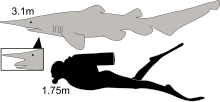
Back قرش عفريت Arabic قرش عفريت ARZ Акула-дамавік Byelorussian Акула-дамавік BE-X-OLD Акула гоблин Bulgarian গবলিন হাঙর Bengali/Bangla Tauró follet Catalan Mitsukurina owstoni CEB Žralok šotek Czech Koboldhai German
| Goblin shark Temporal range: [1]
| |
|---|---|

| |
| Scientific classification | |
| Domain: | Eukaryota |
| Kingdom: | Animalia |
| Phylum: | Chordata |
| Class: | Chondrichthyes |
| Subclass: | Elasmobranchii |
| Subdivision: | Selachimorpha |
| Order: | Lamniformes |
| Family: | Mitsukurinidae |
| Genus: | Mitsukurina |
| Species: | M. owstoni
|
| Binomial name | |
| Mitsukurina owstoni D. S. Jordan, 1898
| |

| |
| Range of the goblin shark[2] | |
| Synonyms | |
| |
The goblin shark (Mitsukurina owstoni) is a rare species of deep-sea shark. Sometimes called a "living fossil", it is the only extant representative of the family Mitsukurinidae, a lineage some 125 million years old. This pink-skinned animal has a distinctive profile with an elongated, flat snout, and highly protrusible jaws containing prominent nail-like teeth. It is usually between 3 and 4 m (10 and 13 ft) long when mature, though it can grow considerably larger such as one captured in 2000 that is thought to have measured 6 m (20 ft).[3] Goblin sharks are benthopelagic creatures that inhabit upper continental slopes, submarine canyons, and seamounts throughout the world at depths greater than 100 m (330 ft), with adults found deeper than juveniles. Some researchers believe that these sharks could also dive to depths of up to 1,300 m (4,270 ft), for short periods of time.[3]
Various anatomical features of the goblin shark, such as its flabby body and small fins, suggest that it is sluggish in nature. This species hunts for teleost fishes, cephalopods, and crustaceans both near the sea floor and in the middle of the water column. Its long snout is covered with ampullae of Lorenzini that enable it to sense minute electric fields produced by nearby prey, which it can snatch up by rapidly extending its jaws. Small numbers of goblin sharks are unintentionally caught by deepwater fisheries. The International Union for Conservation of Nature (IUCN) has assessed it as Least Concern, despite its rarity, citing its wide distribution and low incidence of capture.
- ^ Villafaña, Jaime A.; Marramà, Giuseppe; Klug, Stefanie; Pollerspöck, Jürgen; Balsberger, Markus; Rivadeneira, Marcelo; Kriwet, Jürgen (2020). "Sharks, rays and skates (Chondrichthyes, Elasmobranchii) from the Upper Marine Molasse (middle Burdigalian, early Miocene) of the Simssee area (Bavaria, Germany), with comments on palaeogeographic and ecological patterns". Paläontologische Zeitschrift. 94 (4): 725–757. Bibcode:2020PalZ...94..725V. doi:10.1007/s12542-020-00518-7. PMC 7648011. PMID 33184517. S2CID 219175881.
- ^ a b Finucci, B.; Duffy, C.A.J. (2018). "Mitsukurina owstoni". IUCN Red List of Threatened Species. 2018: e.T44565A2994832. doi:10.2305/IUCN.UK.2018-2.RLTS.T44565A2994832.en. Retrieved 19 November 2021.
- ^ a b Parsons, Glenn R.; Ingram, G. Walter; Havard, Ralph (2002). "First Record of the Goblin Shark Mitsukurina owstoni, Jordan (Family Mitsukurinidae) in the Gulf of Mexico". Southeastern Naturalist. 1 (2): 189–192. doi:10.1656/1528-7092(2002)001[0189:FROTGS]2.0.CO;2. ISSN 1528-7092. JSTOR 3877998. S2CID 86600875.
© MMXXIII Rich X Search. We shall prevail. All rights reserved. Rich X Search
